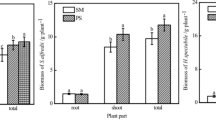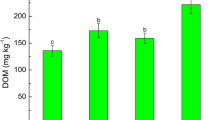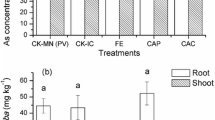Abstract
Soils that are slightly or moderately contaminated with arsenic (As) can be safely utilized by intercropping As hyperaccumulator Pteris vittata with cash crops. Introducing hyperaccumulators into crop planting systems results in the alleviation of the adverse effects of As and competition effect for resources. The balance between these two effects determines intercropping efficiency. The effect of using different hyperaccumulator populations on such balance is the focus of this study. Through a tank experiment, four P. vittata populations were compared on the basis of their intercropping efficiencies and physiological and morphological characteristics. The evaluation of the intercropping efficiency of P. vittata was mainly based on the capabilities of the species to promote growth and decrease As concentrations in intercropped Morus alba. Two populations of P. vittata were appropriate for intercropping with M. alba, with the alleviation effect of As harm as the main effect on the intercropping system. These populations showed extensive root overlap with M. alba and efficient uptake of bioavailable As, thus depleting As in the rhizosphere and lowering As risk. After different P. vittata populations were used, varied interspecific interactions were observed. Root overlap and aboveground morphological parameters are the key factors determining intercropping efficiency among P. vittata populations.









Similar content being viewed by others
References
Azari P, Bostani AA (2017) Reducing As availability in calcareous soils using nanoscale zero valent iron. Environ Sci Pollut Res 24:20438–20445
Borden KA, Thomas SC, Isaac ME (2017) Interspecific variation of tree root architecture in a temperate agroforestry system characterized using ground-penetrating radar. Plant Soil 410:323–334
Caille N, Zhao FJ, McGrath SP (2005) Comparison of root absorption, translocation and tolerance of arsenic in the hyperaccumulator Pteris vittata and the nonhyperaccumulator Pteris tremula. New Phytol 165:755–761
Chandrashekhar AK, Chandrasekharam D, Farooq SH (2016) Contamination and mobilization of arsenic in the soil and groundwater and its influence on the irrigated crops, Manipur Valley, India. Environ Earth Sci 75
Coutinho PWR, de Oliveira PSR, Echer MD, Cadorin DA, Vanelli J (2017) Establishment of intercropping of beet and chicory depending on soil management. Rev Cienc Agron 48:674–682
Cutler WG, Brewer RC, El-Kadi A, Hue NV, Niemeyer PG, Peard J, Ray C (2013) Bioaccessible arsenic in soils of former sugar cane plantations, Island of Hawaii. Sci Total Environ 442:177–188
Das S, Chou ML, Jean JS, Yang HJ, Kim PJ (2017) Arsenic-enrichment enhanced root exudates and altered rhizosphere microbial communities and activities in hyperaccumulator Pteris vittata. J Hazard Mater 325:279–287
Ebrahimi E, Kaul HP, Neugschwandtner RW, Nassab ADM (2017) Productivity of wheat (Triticum aestivum L.) intercropped with rapeseed (Brassica napus L.) Can J Plant Sci 97:557–568
Forino LMC, Castiglione MR, Bartoli G, Balestri M, Andreucci A, Tagliasacchi AM (2012) Arsenic-induced morphogenic response in roots of arsenic hyperaccumulator fern Pteris vittata. J Hazard Mater 235:271–278
Fu JW, Liu X, Han YH, Mei HY, Cao Y, de Oliveira LM, Liu YG, Rathinasabapathi B, Chen YS, Ma LQ (2017) Arsenic-hyperaccumulator Pteris vittata efficiently solubilized phosphate rock to sustain plant growth and As uptake. J Hazard Mater 330:68–75
Garland G, Bunemann EK, Oberson A, Frossard E, Six J (2017) Plant-mediated rhizospheric interactions in maize-pigeon pea intercropping enhance soil aggregation and organic phosphorus storage. Plant Soil 415:37–55
Glowacka A (2014) The influence of strip cropping and adjacent plant species on the content and uptake of N, P, K, Mg and Ca by maize (Zea mays L.) Rom Agric Res 31:219–227
Gonzaga MIS, Santos JAG, Comerford NB, Ma LQ (2007) Comparison of root-system efficiency and arsenic uptake of two fern species. Commun Soil Sci Plant Anal 38:1163–1177
Gonzaga MIS, Santos JAG, Ma LQ (2008) Phytoextraction by arsenic hyperaccumulator Pteris vittata L. from six arsenic-contaminated soils: repeated harvests and arsenic redistribution. Environ Pollut 154:212–218
Huang GX, Chen ZY, Sun JC, Liu F, Wang J, Zhang Y (2015) Effect of sample pretreatment on the fractionation of arsenic in anoxic soils. Environ Sci Pollut Res 22:8367–8374
Jayasumana C, Fonseka S, Fernando A, Jayalath K, Amarasinghe M, Siribaddana S, Gunatilake S, Paranagama P (2015) Phosphate fertilizer is a main source of arsenic in areas affected with chronic kidney disease of unknown etiology in Sri Lanka. Springerplus, pp 4
Kidd P, Mench M, Alvarez-Lopez V, Bert V, Dimitriou I, Friesl-Hanl W, Herzig R, Janssen JO, Kolbas A, Muller I, Neu S, Renella G, Ruttens A, Vangronsveld J, Puschenreiter M (2015) Agronomic practices for improving gentle remediation of trace element-contaminated soils. Int J Phytoremediat 17:1005–1037
Lessl JT, Luo J, Ma LQ (2014) Pteris vittata continuously removed arsenic from non-labile fraction in three contaminated-soils during 3.5 years of phytoextraction. J Hazard Mater 279:485–492
Li S-W, Liu X, Sun H-J, Li M-Y, Zhao D, Luo J, Li H-B, Ma LQ (2017) Effect of phosphate amendment on relative bioavailability and bioaccessibility of lead and arsenic in contaminated soils. J Hazard Mater 339:256–263
Lin LY, Yan XL, Liao XY, Zhang YX, Ma X (2015) Arsenic accumulation in Panax notoginseng monoculture and intercropping with Pteris vittata. Water Air Soil Pollut 226
Lithourgidis AS, Dordas CA, Damalas CA, Vlachostergios DN (2011) Annual intercrops: an alternative pathway for sustainable agriculture. Aust J Crop Sci 5:396–410
Ma LQ, Komar KM, Tu C, Zhang WH, Cai Y, Kennelley ED (2001) A fern that hyperaccumulates arsenic—a hardy, versatile, fast-growing plant helps to remove arsenic from contaminated soils. Nature 409:579–579
Ma L, Yang ZG, Li L, Wang L (2016) Source identification and risk assessment of heavy metal contaminations in urban soils of Changsha, a mine-impacted city in Southern China. Environ Sci Pollut Res 23:17058–17066
Morris RA, Garrity DP (1993) Resource capture and utilization in intercropping; non-nitrogen nutrients. Field Crop Res 34:319–334
Poynton CY, Huang JWW, Blaylock MJ, Kochian LV, Elless MP (2004) Mechanisms of arsenic hyperaccumulation in Pteris species: root As influx and translocation. Planta 219:1080–1088
Punshon T, Jackson BP, Meharg AA, Warczack T, Scheckel K, Guerinot ML (2017) Understanding arsenic dynamics in agronomic systems to predict and prevent uptake by crop plants. Sci Total Environ 581:209–220
Puschenreiter M, Wieczorek S, Horak O, Wenzel WW (2003) Chemical changes in the rhizosphere of metal hyperaccumulator and excluder Thlaspi species. J Plant Nutr Soil Sci Z Pflanzenernahr Bodenkd 166:579–584
Qin H, He ZJ, Xiong JF, Chen L, Bi Y (2012) Effects of intercropping on the contents and accumulation of heavy metals in maize varieties and Pteris cretica L. J Agro-Environ Sci 31:1281–1288
Qiu D, Du R, Meng D, Gu M, He B, Wei Y, Wang X (2017) Effect of maize (Pteris vittata L.) intercropping on remediation of As-contaminated farmland soil. J Agro-Environ Sci 36:101–107
Quazi S, Datta R, Sarkar D (2011) Effects of soil types and forms of arsenical pesticide on rice growth and development. Int J Environ Sci Technol 8:445–460
Ren YY, Wang XL, Zhang SQ, Palta JA, Chen YL (2017) Influence of spatial arrangement in maize-soybean intercropping on root growth and water use efficiency. Plant Soil 415:131–144
Robson TC, Braungardt CB, Keith-Roach MJ, Rieuwerts JS, Worsfold PJ (2013) Impact of arsenopyrite contamination on agricultural soils and crops. J Geochem Explor 125:102–109
Santalla M, Rodino AP, Casquero PA, de Ron AM (2001) Interactions of bush bean intercropped with field and sweet maize. Eur J Agron 15:185–196
Santos JAG, Gonzaga MIS, Ma LQ, Srivastava M (2008) Timing of phosphate application affects arsenic phytoextraction by Pteris vittata L. of different ages. Environ Pollut 154:306–311
Srivastava M, Santos J, Srivastava P, Ma LQ (2010) Comparison of arsenic accumulation in 18 fern species and four Pteris vittata accessions. Bioresour Technol 101:2691–2699
Tang Y, He J, Yu X, Xie Y, Lin L, Sun G, Li H, Liao M, Liang D, Xia H, Wang X, Zhang J, Liu Z, Tu L, Liu L (2017) Intercropping with Solanum nigrum and Solanum photeinocarpum from two ecoclimatic regions promotes growth and reduces cadmium uptake of eggplant seedlings. Pedosphere 27:638–644
Tyrovola K, Nikolaidis NP (2009) Arsenic mobility and stabilization in topsoils. Water Res 43:1589–1596
Unlu H, Unlu HO, Dasgan HY, Solmaz I, Sari N, Kartal E, Uzen N (2008) Effects of intercropping on plant nutrient uptake in various vegetables species. Asian J Chem 20:4781–4791
Verma KS, Kohli S, Kaushal R, Chaturvedi OP (2014) Root structure, distribution and biomass in five multipurpose tree species of Western Himalayas. J Mt Sci 11:519–525
Wahla IH, Ahmad R, Ehsanullah, Ahmad A, Jabbar A (2009) Competitive functions of components crops in some barley based intercropping systems. Int J Agric Biol 11:69–72
Wan X-M, Lei M, Liu Y-R, Huang Z-C, Chen T-B, Gao D (2013) A comparison of arsenic accumulation and tolerance among four populations of Pteris vittata from habitats with a gradient of arsenic concentration. Sci Total Environ 442:143–151
Wan XM, Lei M, Chen TB, Tan YB, Yang JX (2017a) Safe utilization of heavy-metal-contaminated farmland by mulberry tree cultivation and silk production. Sci Total Environ 599:1867–1873
Wan XM, Lei M, Chen TB, Yang JX (2017b) Intercropped Pteris vittata L. and Morus alba L. presents a safe utilization mode for arsenic-contaminated soil. Sci Total Environ 579:1467–1475
Wang HB, Wong MH, Lan CY, Baker AJM, Qin YR, Shu WS, Chen GZ, Ye ZH (2007) Uptake and accumulation of arsenic by 11 Pteris taxa from southern China. Environ Pollut 145:225–233
Wenzel WW, Kirchbaumer N, Prohaska T, Stingeder G, Lombi E, Adriano DC (2001) Arsenic fractionation in soils using an improved sequential extraction procedure. Anal Chim Acta 436:309–323
Willey RW, Osiru DSO (1972) Studies on mixtures of maize and beans (Phaseolus-vulgaris) with particular reference to plant population. J Agric Sci 79:517-&
Yoon Y, Lee WM, An YJ (2015) Phytotoxicity of arsenic compounds on crop plant seedlings. Environ Sci Pollut Res 22:11047–11056
Zhang Y, Ni J, Yang J, Zhang T, Xie D (2017) Citrus stand ages regulate the fraction alteration of soil organic carbon under a citrus/Stropharua rugodo-annulata intercropping system in the Three Gorges Reservoir area, China. Environ Sci Pollut Res 24:18363–18371
Funding
Financial support was provided by the National Key Research and Development Program of China (Grant No. 2017YFD0800900), the National Natural Science Foundation of China (Grant No. 41301547), and grants from the Youth Innovation Promotion Association of the Chinese Academy of Sciences.
Author information
Authors and Affiliations
Corresponding author
Additional information
Responsible editor: Elena Maestri
Electronic supplementary material
Fig. S1
(DOCX 296 kb)
Rights and permissions
About this article
Cite this article
Wan, X., Lei, M. Intercropping efficiency of four arsenic hyperaccumulator Pteris vittata populations as intercrops with Morus alba. Environ Sci Pollut Res 25, 12600–12611 (2018). https://doi.org/10.1007/s11356-018-1366-y
Received:
Accepted:
Published:
Issue Date:
DOI: https://doi.org/10.1007/s11356-018-1366-y




